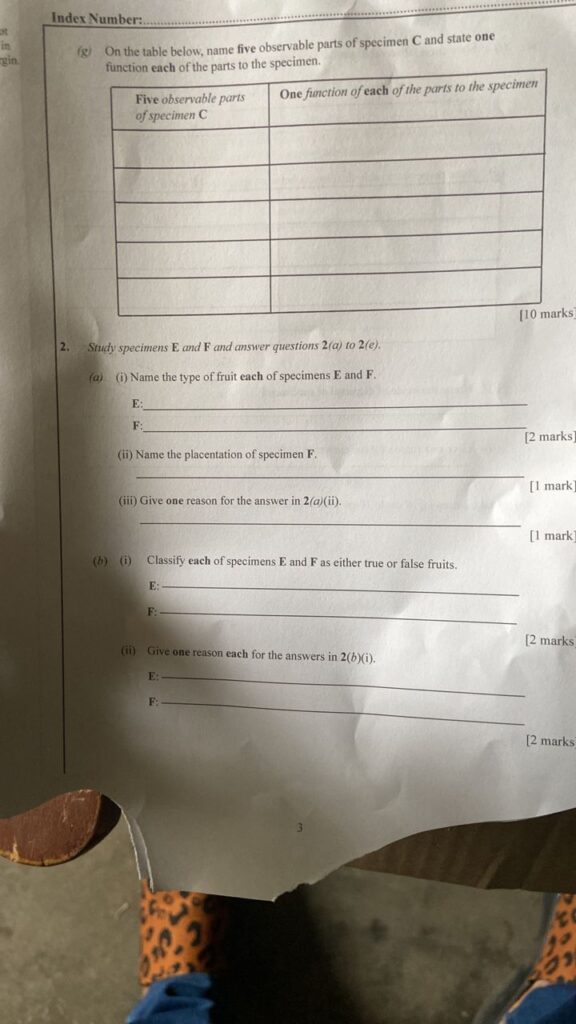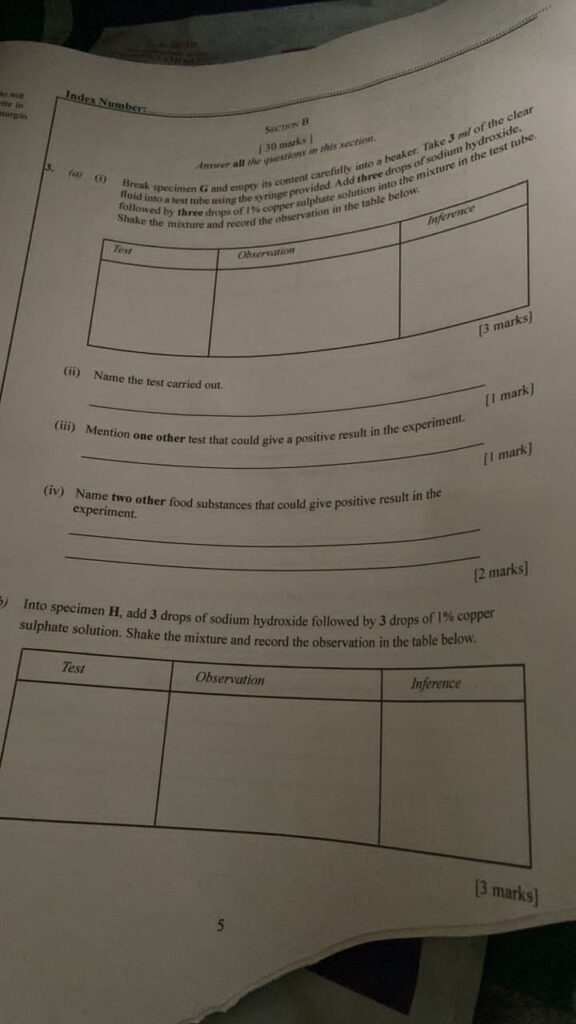
WAEC BIOLOGY QUESTIONS BY EXAMGRANDCOMNG




WAEC 2025 BIOLOGY PRACTICAL;-ExamgrandComNg
NUMBER ONE
(1a)
(i) Phylum: Arthropoda
(ii) Class: Insecta
(1b)
(PICK THREE ONLY)
(i) Presence of three body parts: head, thorax, and abdomen
(ii) Possession of three pairs of jointed legs
(iii) Presence of one or two pairs of wings
(iv) Presence of antennae
(v) Body covered with an exoskeleton
(vi) Undergoes metamorphosis
(1c)
Parasitism
(1d)
(PICK TWO ONLY)
(i) Hard mandibles for boring into seeds
(ii) Compact body to fit into small spaces
(iii) Brownish color for camouflage within beans
(iv) Strong legs for clinging to the seed surface
(v) Ability to lay eggs inside seeds for the protection of larvae
(1e)
(PICK TWO ONLY)
(i) Sun-drying to reduce the moisture content
(ii) Storing in airtight containers
(iii) Use of insecticides or fumigants
(iv) Freezing or refrigerating
(v) Use of natural repellents like dried pepper or neem leaves
(1fi)
(PICK TWO ONLY)
(i) Used as a food source rich in protein
(ii) Used for making bean flour and other processed foods
(iii) Serves as livestock feed
(iv) Used in crop rotation to fix nitrogen
(v) Source of income for farmers and traders
(1fii)
Protein
(1g)
(COMPLETE THE TABLE)
=Five Observable Parts of Specimen C=
(i) Leaf
(ii) Stem
(iii) Root
(iv) Flower
(v) Bud
=One Function of Each of the Parts to the Specimen=
(i) Carries out photosynthesis to produce food
(ii) Supports the plant and transports water and nutrients
(iii) Anchors the plant and absorbs water and minerals
(iv) Involved in reproduction and attracts pollinators
(v) Develops into a new flower or leaf.
================================
(2ai)
E (Pineapple): Multiple fruit
F (Orange): Berry
(2aii)
Axile placentation
(2aiii)
The ovules/seeds are attached to a central column within the ovary, characteristic of axile placentation.
(2bi)
E (Pineapple): False fruit (accessory fruit)
F (Orange): True fruit
(2bii)
E (Pineapple): It develops from the inflorescence (multiple flowers) and includes tissues other than the ovary.
F (Orange): It develops solely from the ovary of a single flower.
(2ci)
(i) Both are fleshy fruits.
(ii) Both contain seeds.
(iii) Both have a tough outer skin (rind).
(2cii)
[TABULATE]
=E (Pineapple)=
(i) Made up of many fused flowers/fruits
(ii) Has a rough, spiny outer skin
(iii) Seeds are scattered throughout flesh
=F (Orange)=
(i) Develops from a single flower
(ii)Has a smooth, leathery outer skin
(iii) Seeds are located in central locules
(2di)
Animal (or zoochory)
(2dii)
The fruit is fleshy, juicy, and attractive, encouraging animals to eat it and disperse the seeds.
(2e)

================================
(3ai)
(IN TABULAR FORM)
(i) Test: Biuret test for protein
(ii) Observation: Violet or purple coloration
(iii) Inference: Protein is present
(3aii)
Biuret test
(3aiii)
Millon’s test
(3aiv)
(i) Milk
(ii) Meat
(3b)
(IN A TABULAR FORM)
(i) Test: Biuret test
(ii) Observation: No color change
(iii) Inference: Protein is absent
(3c)
(IN A TABULAR FORM)
-Five Observable Parts Of Specimen J-
(i) Eggshell
(ii) Egg white (albumen)
(iii) Egg yolk
(iv) Chalaza
(v) Egg membrane
-One Function of Each of the Parts-
(i) Protects the internal contents from damage and microbes
(ii) Provides water and protein for the embryo
(iii) Supplies nutrients (fats and vitamins) to the embryo
(iv) Holds the yolk in position within the egg
(v) Serves as an additional protective barrier
(3d)
(i) Kingdom: Animalia
(ii) Phylum: Chordata
(iii) Class: Aves
(3e)
(PICK ANY TWO)
(i) It serves as a rich source of high-quality protein in human diets.
(ii) It is used in baking and food industries (e.g., cakes, pastries, mayonnaise).
(iii) It provides income to poultry farmers and egg sellers.
(iv) It is used in the production of vaccines (e.g., for influenza).
(v) It is used in laboratory experiments and biological research.
(vi) It contributes to job creation in poultry production and distribution.
(vii) It is used in cosmetics and hair treatment products (e.g., egg masks).
(3f)
(PICK ANY TWO)
(i) Poultry farms
(ii) Domestic backyards
(iii) Open rural compounds
(iv) Forests (for wild birds)
(v) Water bodies (for ducks and geese)
(vi)Agricultural villages
(vii) Aviaries or bird sanctuaries
(3g)
(PICK ANY THREE)
(i) Domestic fowl (chicken)
(ii) Duck
(iii) Turkey
(iv) Goose
(v) Guinea fowl
(vi) Quail
(vii) Ostrich






Be the first to comment